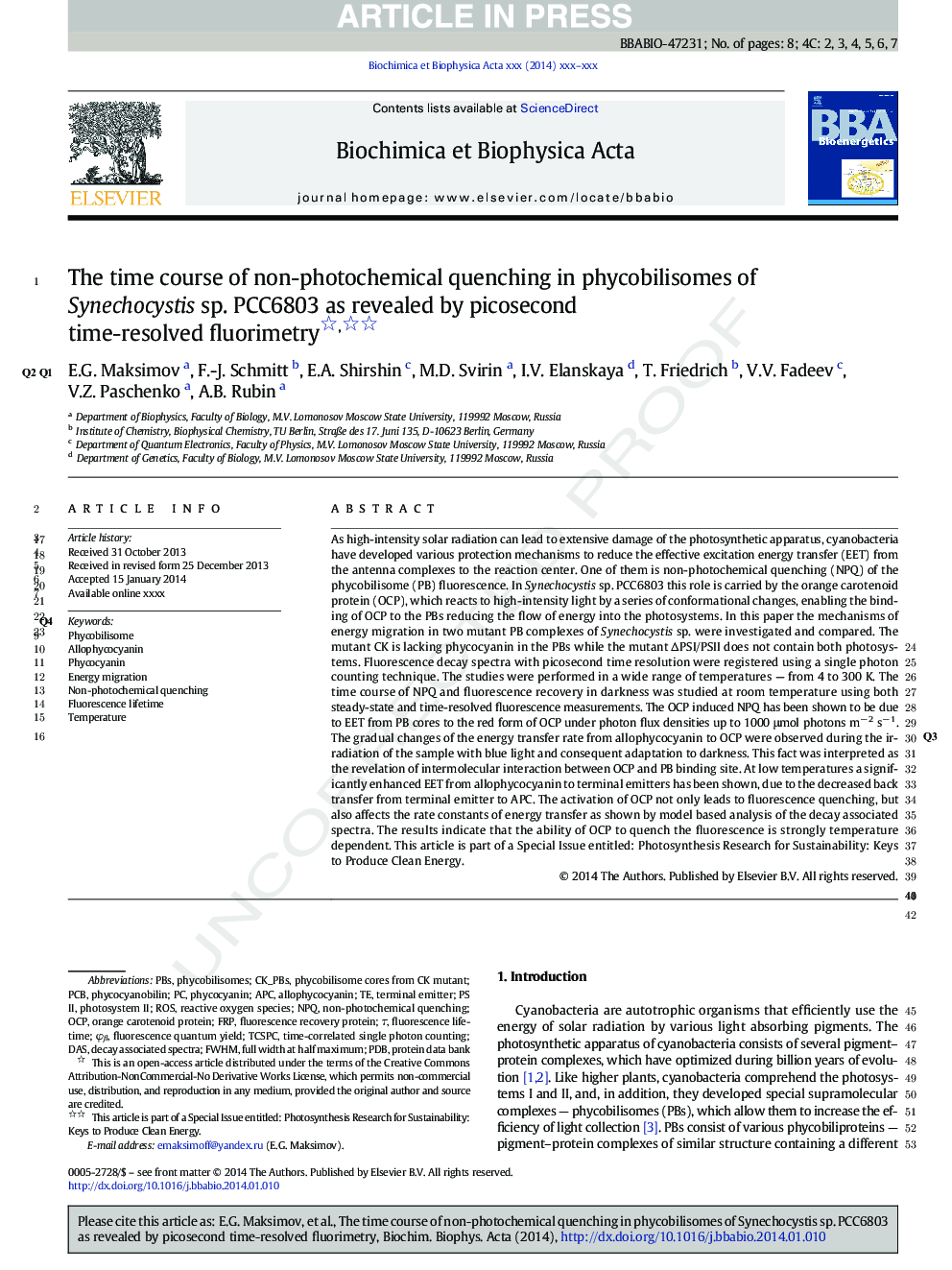| کد مقاله | کد نشریه | سال انتشار | مقاله انگلیسی | نسخه تمام متن |
|---|---|---|---|---|
| 1942180 | 1052585 | 2014 | 8 صفحه PDF | دانلود رایگان |
عنوان انگلیسی مقاله ISI
The time course of non-photochemical quenching in phycobilisomes of Synechocystis sp. PCC6803 as revealed by picosecond time-resolved fluorimetry
دانلود مقاله + سفارش ترجمه
دانلود مقاله ISI انگلیسی
رایگان برای ایرانیان
کلمات کلیدی
PDBPhycobilisomePhycocyanobilinPS IIPhycobilisomesNPQFWHMAPCPhycocyaninDASTCSPCPBSOCPPCBROS - ROSallophycocyanin - آلوفوکسیانینNon-photochemical quenching - خنک سازی غیر فتوشیمیاییTemperature - دماTime-correlated single photon counting - شمارش تک فوتون وابسته به زمانFluorescence lifetime - طول عمر فلورسانسDecay associated spectra - طیف مربوطه را کاهش دهیدfull width at half maximum - عرض کامل در نیمی از حداکثرFluorescence quantum yield - عملکرد کوانتومی فلورسانسPhotosystem II - فتوسیستم 2FRP - فیبرهای پلیمری تقویت شده Energy migration - مهاجرت انرژیProtein Data Bank - پروتئین بانک اطلاعاتیOrange carotenoid protein - پروتئین کاروتنوئید نارنجیReactive oxygen species - گونههای فعال اکسیژن
موضوعات مرتبط
علوم زیستی و بیوفناوری
علوم کشاورزی و بیولوژیک
دانش گیاه شناسی
پیش نمایش صفحه اول مقاله

چکیده انگلیسی
As high-intensity solar radiation can lead to extensive damage of the photosynthetic apparatus, cyanobacteria have developed various protection mechanisms to reduce the effective excitation energy transfer (EET) from the antenna complexes to the reaction center. One of them is non-photochemical quenching (NPQ) of the phycobilisome (PB) fluorescence. In Synechocystis sp. PCC6803 this role is carried by the orange carotenoid protein (OCP), which reacts to high-intensity light by a series of conformational changes, enabling the binding of OCP to the PBs reducing the flow of energy into the photosystems. In this paper the mechanisms of energy migration in two mutant PB complexes of Synechocystis sp. were investigated and compared. The mutant CK is lacking phycocyanin in the PBs while the mutant ÎPSI/PSII does not contain both photosystems. Fluorescence decay spectra with picosecond time resolution were registered using a single photon counting technique. The studies were performed in a wide range of temperatures - from 4 to 300 K. The time course of NPQ and fluorescence recovery in darkness was studied at room temperature using both steady-state and time-resolved fluorescence measurements. The OCP induced NPQ has been shown to be due to EET from PB cores to the red form of OCP under photon flux densities up to 1000 μmol photons mâ 2 sâ 1. The gradual changes of the energy transfer rate from allophycocyanin to OCP were observed during the irradiation of the sample with blue light and consequent adaptation to darkness. This fact was interpreted as the revelation of intermolecular interaction between OCP and PB binding site. At low temperatures a significantly enhanced EET from allophycocyanin to terminal emitters has been shown, due to the decreased back transfer from terminal emitter to APC. The activation of OCP not only leads to fluorescence quenching, but also affects the rate constants of energy transfer as shown by model based analysis of the decay associated spectra. The results indicate that the ability of OCP to quench the fluorescence is strongly temperature dependent. This article is part of a Special Issue entitled: Photosynthesis Research for Sustainability: Keys to Produce Clean Energy.
ناشر
Database: Elsevier - ScienceDirect (ساینس دایرکت)
Journal: Biochimica et Biophysica Acta (BBA) - Bioenergetics - Volume 1837, Issue 9, September 2014, Pages 1540-1547
Journal: Biochimica et Biophysica Acta (BBA) - Bioenergetics - Volume 1837, Issue 9, September 2014, Pages 1540-1547
نویسندگان
E.G. Maksimov, F.-J. Schmitt, E.A. Shirshin, M.D. Svirin, I.V. Elanskaya, T. Friedrich, V.V. Fadeev, V.Z. Paschenko, A.B. Rubin,